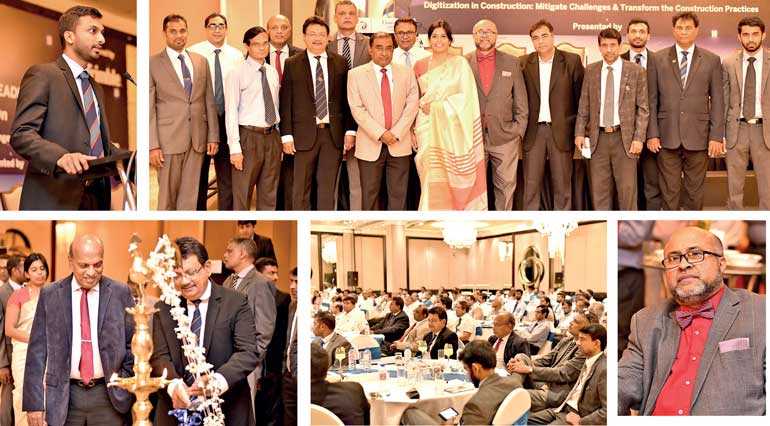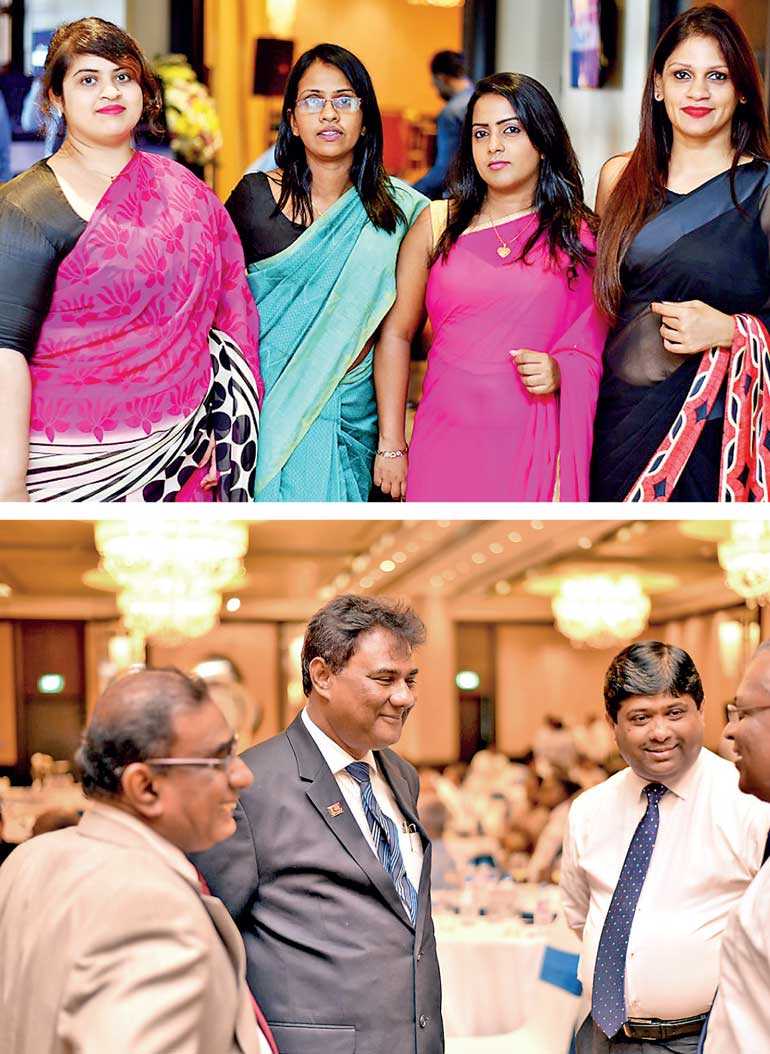Friday Apr 26, 2024
Friday Apr 26, 2024
Friday, 18 May 2018 00:00 - - {{hitsCtrl.values.hits}}


 Information communication technology has pervaded every aspect of business processes across all industries. In spite of this, the use of these technologies in the construction industry has been restricted only to a few areas such as designing and office automation. The majority of the processes in the construction industry have remained untouched by these technologies. But all this is changing.
Information communication technology has pervaded every aspect of business processes across all industries. In spite of this, the use of these technologies in the construction industry has been restricted only to a few areas such as designing and office automation. The majority of the processes in the construction industry have remained untouched by these technologies. But all this is changing.
As a result of recent developments around the world, leading international construction companies are adopting modern technologies to redefine the construction process in different areas such as design, project delivery, lifecycle performance, affordability and disaster resilience.
This was the main theme of the ‘Construction Leadership Forum’ jointly organised by the National Construction Association of Sri Lanka (NCCSL), Ceylon Institute of Builders (CIOB), Major Constructors of Sri Lanka (MCSL) and Young Constructors Forum (YCF) recently at Hotel Cinnamon Lakeside. The forum was sponsored by Trimble Solutions.
NCASL Director and CIOB Vice President Ruwan De Silva mentioned that the objectives of organising the Construction Leadership Forum were to bring together various stakeholders from the construction industry to apprise them of the new technologies that were impacting the construction industry worldwide and to discuss the issues facing the local industry with a view of identifying and developing possible strategies to address these issues.
He went on to highlight the importance of preserving the environment by minimising the use of non-renewable resource material and decreasing greenhouse gas emissions. He commented on the Sustainable Development Goals, a set of 17 goals formulated by the United Nations and adopted by 193 countries in 2015 to end poverty, protect the planet and ensure prosperity for all.
As a signatory to this, Sri Lanka has to achieve the SDG goals and their targets by 2030. In this regard, De Silva, who also serves as the Honorary SDG Diplomacy Governor, asserted that most of the materials used by the construction industry were non-renewable and hence the country needed to minimise the use of resource material. Therefore, there was a need for the construction industry to minimise the wastage of resource material. He went on to say that the use of modern technologies would help greatly in decreasing wastage in the construction industry.
Since many of the associations representing the construction industry were involved in organising the event, the seminar saw a large number of participants representing a wide spectrum of construction industry stakeholders, including both large and small construction firms.
In addition, a large number of architects, academics and building consultants attended the seminar. NCASL Chairman Athula Priyantha Galagoda delivered the welcome address.
Trimble Solutions Inc. Regional Director Eng. Harsh Pareek addressed the audience on topics such as Construction Challenges and Business Environment, Constructability (Constructible BIM) and International Case Studies of Successful Projects.
He explained how 3D CAD and other major IT systems that were hitherto primarily used only in the design stages of the project were beginning to be used in the entire building process of a construction project with the aid of network communication systems, GPS and smartphones.
He also spoke about the 5D BIM (Building Information Modeling) which links individual 3D CAD components to time schedule and cost-related information.
He added that with 5D BIM technology, one or more accurate virtual models of a building were constructed digitally. These building models that were mainly used by architects at the design stages earlier could now be designed in such a way that it could contain the information necessary to carry out the entire project through various phases, allowing better analysis and control than manual processes. When completed, these computer-generated models contain the precise geometry and data needed to support construction, fabrication and procurement activities through which the building is realised. They can even contain the entire bill of materials needed for the project.
His speech was followed by a product demonstration by Trimble Solutions where they demonstrated the automation of a building construction project using the Tekla software product suite. The audience was able to witness that all the stakeholders of the building project, starting from owners, architects, design engineers, site engineers, contractors and MEP contractors, were able to have up to date information on the project and were able to collaborate more effectively.
Panel discussion
This was followed by a panel discussion on ‘Construction Industry Challenges & Scope of Technology Adoption’. CIOB President Dr. Rohan Karunaratne and Sri Lanka Institute of Architects President Archt. H Wijewardena served as joint chairs and KDA Weerasinghe & Co. Director Eng. Menuwan Weerasinghe moderated the discussion.
The other members of the panel were Priyantha Perera – President, Major Constructors of Sri Lanka; Major Eng. Ranjith Gunatilleke - Managing Director, Sanken Construction; Eng. Mega Kularatne - Director, Maga Engineering; Eng. Shanika Cabraal – President, Young Constructors Forum; Capt. Gayan Tudawe – Director, Tudawe Brothers Ltd. and Eng. Harsh Pareek – Regional Sales Director, Trimble Solutions.
Panel members and the audience enthusiastically participated in the ensuing discussion which saw a lot of useful suggestions being aired by the participants. One concern some participants had was that the cost involved in adopting new technologies was rather high for Sri Lankan companies. However, many were of the opinion that even though the cost was high, companies had no choice but to adopt these technologies if they wanted to compete against multinational construction firms, both domestically as well as internationally.
Further, the implementation of these technologies can effectively reduce waste and save time which will more than offset the cost of procuring such a system. There were also suggestions that the Government should have a special fund to subsidise the cost involved in implementing such at solution in small and medium-scale construction companies. It was emphasised that by setting up a fund to encourage construction companies to invest in research and development and innovation as well as to enable them to procure modern technologies, the Government would be able to save large sums of money due to saving time, minimising cost and maximising productivity. The Government needs to spend billions for infrastructure projects and hence improving the productivity of the construction companies by a small percentage will enable the country to save huge sums of money.
Commenting on this subject, De Silva mentioned that goal No. 9 of the UN SDG Goals refers to Industry, Innovation and Infrastructure. In this regard, many multilateral agencies such as the UNDP, World Bank, ADB, JICA and KOICA offer funding through the Government to companies to implement measures that will contribute towards the achievement of the SDG goals. Therefore, we should request the Government to form a public private partnership (PPP) mechanism to channel these funds to the industry stakeholders. He offered to collaborate with the Government and the multilateral agencies to facilitate this.
Eng. Shanika Cabraal, president of Young Constructors Forum underscored the need for the Government to allocate a fund for establishing research and development infrastructure at universities and partner with industry organisations to provide on-the-job training for students.
Many of the participants revealed that there was a need for the industry to work closely with universities for knowledge-sharing and to foster industry-related research and development.
In this regard, Eng. Harsh Pareek informed the audience of Trimble Solutions’ intention to fund construction innovation laboratories at Sri Lankan universities and invited the university academics present to work with Trimble in this endeavour.
He also pointed out that there was a need to train professionals in the use of 5D BIM for it to be successfully implemented at organisations and Trimble was willing to work with commercial training providers to offer 5D BIM courses. The forum concluded with a fellowship and dinner.